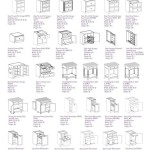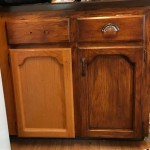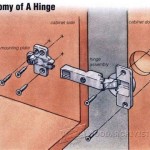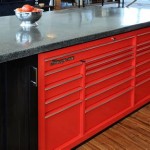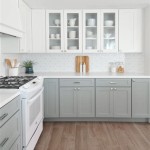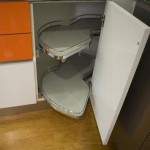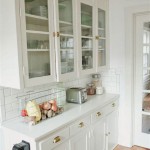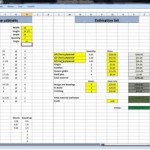How Can I Tell if My Kitchen Cabinets Are Real Wood?
Discerning whether kitchen cabinets are constructed from solid wood or alternative materials requires careful observation and a basic understanding of cabinet construction. Several key indicators can help determine the true composition of the cabinetry.
Visual Inspection: One of the initial steps involves a thorough visual inspection. Examine the cabinet doors, paying close attention to the grain. Solid wood exhibits a natural, continuous grain pattern that extends across the entire surface. Manufactured wood products, such as particleboard or MDF (medium-density fiberboard), often feature a repetitive or uniform grain pattern, indicative of a printed or laminated surface. Look closely at the edges of the doors and drawers. Solid wood will typically reveal the layered structure of the wood, showcasing the end grain. Veneered pieces will display a thin layer of wood glued to a substrate, often visible as a distinct line where the veneer meets the core material.
Weight and Density: Solid wood cabinets tend to be heavier and denser than those made from composite materials. Lift a cabinet door or drawer; the substantial weight often suggests solid wood construction. While some engineered woods can be quite dense, they often lack the heft of natural wood.
Sound Test: Tapping on the cabinet surfaces can provide further clues. Solid wood produces a deeper, more resonant sound compared to the hollow or dull thud characteristic of particleboard or MDF. This method is not foolproof, as some high-quality engineered woods can mimic the sound of solid wood, but it can be a useful indicator when combined with other observations.
Construction Techniques: Examine the joinery and construction methods used in the cabinets. Solid wood cabinets frequently employ joinery techniques like dovetail joints, mortise and tenon joints, or dowel joints. These methods are indicative of traditional woodworking craftsmanship and are less common in cabinets made from manufactured wood products. Cabinets made with composite materials often rely on staples, glue, and screws for assembly.
Unfinished Areas: Inspect the inside of the cabinets, the back panels, and any unfinished areas. These sections often provide a clearer view of the core material. Solid wood cabinets will consistently display wood throughout their construction. If the core material appears to be a composite material, the cabinet likely features a veneer or laminate finish.
Inspecting Drawers: Drawer construction offers valuable insights into the overall cabinet quality and materials. Solid wood drawers typically feature dovetail joinery at the corners, a sign of robust construction. The drawer sides and bottoms should also be made of solid wood. Particleboard or MDF drawers often utilize simpler joinery methods and may have thinner, less durable bottoms.
The Smell Test: While not a definitive method, the smell test can sometimes be helpful. Solid wood cabinets, especially those made from certain wood species like cedar or pine, may emit a subtle woody aroma. Cabinets made from composite materials may have a faint chemical odor, especially if they are newer.
Consider the Price: While not a definitive indicator of material, price can sometimes offer a clue. Solid wood cabinets are generally more expensive than those made from composite materials due to the higher cost of materials and labor. A significantly lower price point might suggest the use of manufactured wood products.
Ask the Manufacturer or Retailer: If the cabinets are new and still under warranty, contacting the manufacturer or retailer is often the most straightforward way to confirm the materials used. They should be able to provide detailed information about the cabinet construction, including the type of wood and any veneers or laminates used.
Professional Assessment: If uncertainty remains, consulting a professional furniture maker, carpenter, or cabinet installer can provide expert analysis. They possess the knowledge and experience to identify different wood types and construction techniques, offering a definitive assessment of the cabinet's composition.
Understanding Veneers: It's important to note that the presence of a veneer does not necessarily indicate a low-quality cabinet. Veneers are thin layers of real wood applied to a substrate, often a more stable engineered wood. High-quality veneers can offer the aesthetic appeal of solid wood at a lower cost and can be more resistant to warping or cracking than solid wood in some environments. Recognizing the difference between a solid wood cabinet and a veneered cabinet requires careful observation of the edges and unfinished areas.
The Importance of Accurate Identification: Identifying the composition of kitchen cabinets is important for various reasons. Understanding the materials helps inform decisions about maintenance, repairs, and potential refinishing projects. Different wood types and finishes require specific care and cleaning methods. Knowing the underlying material also helps assess the overall value and durability of the cabinetry.

How To Tell If Cabinets Are Real Wood Or Laminate Doityourself Com Community Forums

How To Tell If Cabinets Are Real Wood Or Laminate Doityourself Com Community Forums

How To Tell If Wood Furniture Is Real Or Fake Erin Spain

How Do You Tell If Your Cabinets Are Laminate Cabinetdoormart Com

How To Tell If Wood Furniture Is Real Or Fake Erin Spain

How To Tell If You Have Real Wood Cabinets Or Fake Ones

Painted Wood Cabinets Vs Stained A Questionnaire Kylie M Interiors

How Do You Tell If Your Cabinets Are Laminate Cabinetdoormart Com

Farmhouse Check In A What We Chose Edition Stained Wood Or Painted Cabinets Emily Henderson

Solid Wood Cabinets Know Your Woods
Related Posts

